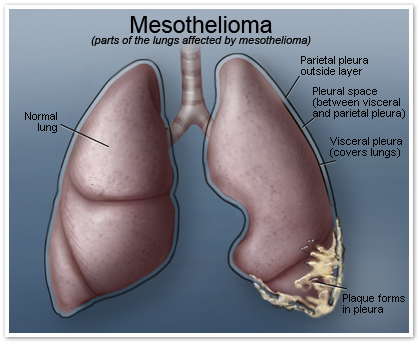Sunday, January 19, 2014
Introduction & History of Mesothelioma
Introduction
Background
Malignant mesothelioma is an aggressive tumor that originates in the serosal
membranes that line the thoracic and abdominal cavities. This disease has become
an important health issue over recent years, with Australia having one of the highest
reported incidences (2-4). More than 90% of reported cases of mesothelioma occur in
the pleura, compared with 4–7% affecting the peritoneum, and fewer than 1% jointly
occurring in the pericardium and tunica vaginalis testis (2, 4, 5). Even rarer cases have
been recorded as apparently primary ovarian mesotheliomas ).
The occurrence of malignant mesothelioma is typically related to exposure to mineral
fibres such as asbestos and erionite (8-10). Asbestos is a collection of naturally occurring
crystalline hydrated silicates that are resistant to high temperatures and humidity.
Asbestos fibres are biopersistent (retained in the human body) and can be detected as
asbestos bodies’ in the lung many years after inhalation ).
The World Health Organization (WHO) has recognised asbestos as one of the most
important occupational carcinogens and in 2010 upgraded its global estimate of asbestosrelated
diseases to 107,000 annual deaths ).
History of mesothelioma
The first studies on the association between asbestos and malignant mesothelioma
appeared in the 1950s. Weiss’ case report of asbestosis and pleural malignancy and Van
der Schoot’s paper describing three insulation workers with malignant disease were the
first of many to be published (13, 14). Wagner confirmed the association between asbestos
and malignant mesothelioma through his work in the 1950s in South Africa,
Because most asbestos exposure occurred in the work environment, malignant
mesothelioma has traditionally been considered an occupational disease. Paraoccupational
malignant mesothelioma has been described in households of asbestos
workers in which cohabitants had been exposed via contaminated clothes (16). The term
‘environmental malignant mesothelioma’ has been used to describe disease identified in
people living close to asbestos mines or factories or when people have been exposed to
asbestos or asbestos-like material present in the soil (17, 18).
Other factors have been recognised as potential causes of malignant mesothelioma.
Radiotherapy to the chest has been reported but the number of patients with this
association is limited (19). The role of SV40 (one of the simian viruses) viral infection as an
important etiologic cofactor in malignant mesothelioma remains under discussion (20, 21).
Exposure to asbestos is more common in occupations with a predominantly male workforce,
which explains why the current incidence of malignant mesothelioma is higher among men
than women. Most mesothelioma patients have been primary asbestos workers or people
who handled raw asbestos in the mining, milling, transportation and manufacturing of the
material. As this high-risk occupational exposure has been limited by the total ban on the
use of asbestos products in Australia, the exposure-mix may change to include a greater
proportion of people who have been exposed in non-occupational settings.
13
| Guidelines for the Diagnosis and Treatment of Malignant Pleural Mesothelioma |
A dose-response relationship between cumulative asbestos exposure (increased levels or
duration of exposure, or both) and malignant mesothelioma has been demonstrated ).
A ‘safe’ threshold of cumulative exposure, below which there is no increased risk, has not
been defined.
The latency period, or the period between first exposure to asbestos and the diagnosis
of mesothelioma, shows a wide range (20–60 years) and there are indications that the
latency in Australia has increased in recent years . The median age at diagnosis of
malignant mesothelioma in Australia is slightly above 70 years, with many patients
presenting with co-morbidities












0 comments:
Post a Comment